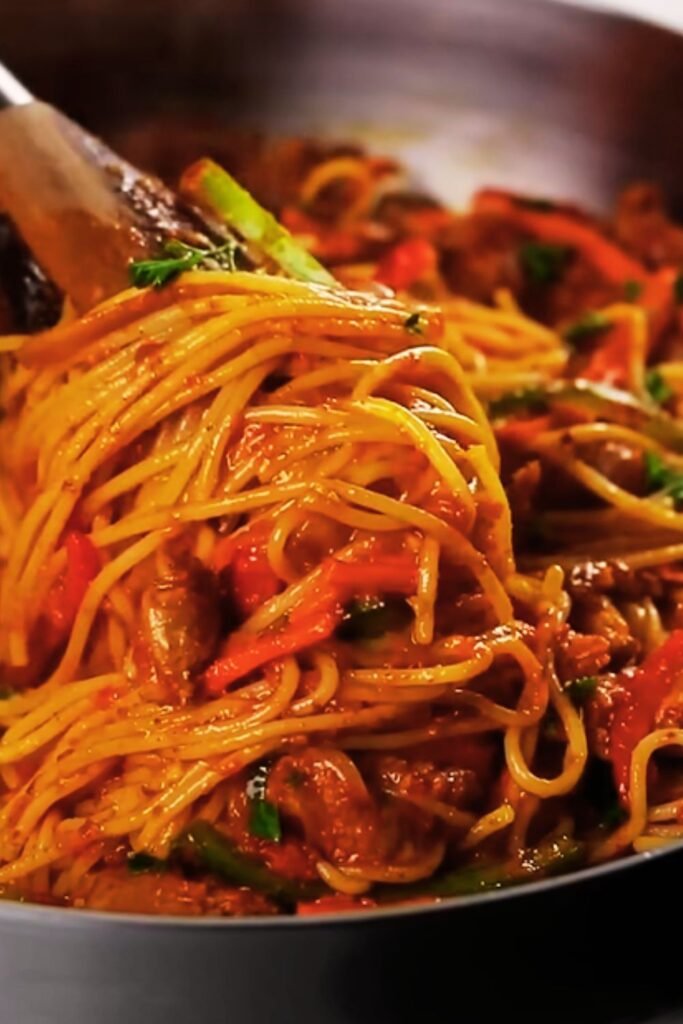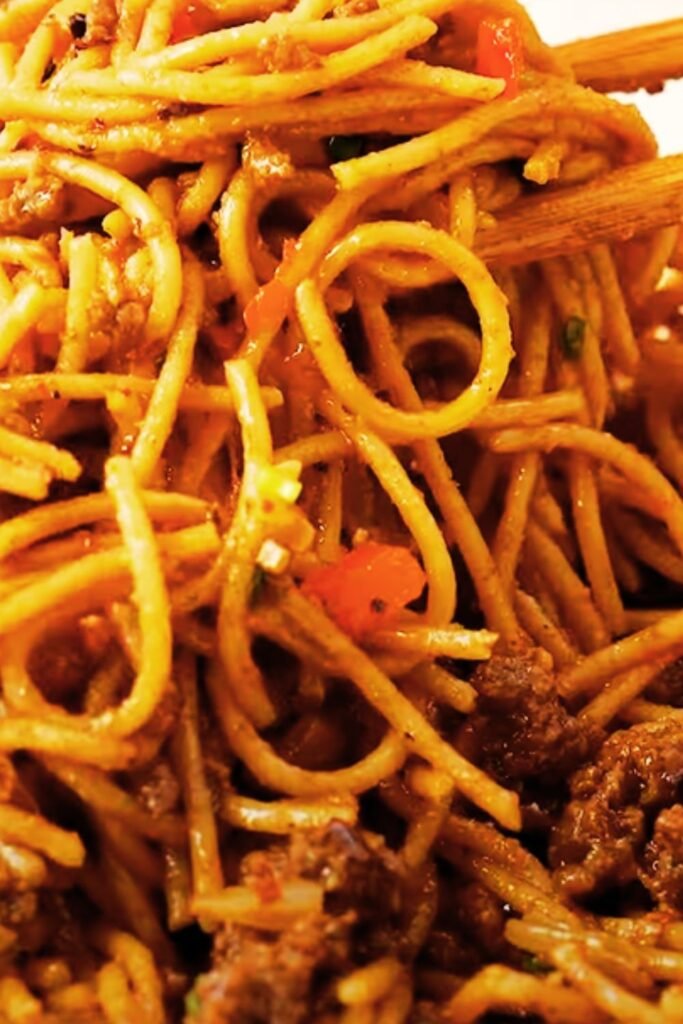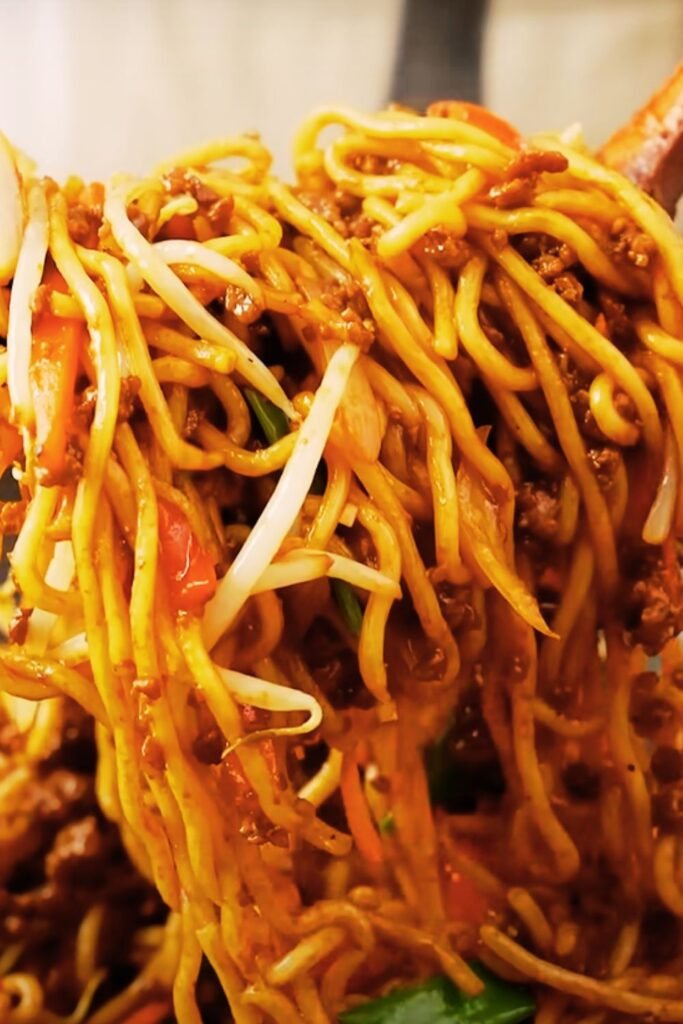When I first moved out on my own, I was constantly searching for meals that wouldn’t break the bank but still satisfied my craving for something flavorful and filling. That’s when I discovered this incredible fusion dish that combines the comfort of Italian pasta with the bold, umami-rich flavors of Asian cuisine. This budget-friendly Asian beef spaghetti has become my go-to recipe whenever I want something quick, delicious, and wallet-friendly.
What makes this dish so special is how it transforms simple, affordable ingredients into something that tastes like it came from an upscale fusion restaurant. The marriage of tender beef, perfectly cooked spaghetti, and a savory Asian-inspired sauce creates a harmony of flavors that will have your taste buds dancing. I’ve served this to countless friends and family members, and it never fails to impress.
The beauty of this recipe lies in its versatility and accessibility. You don’t need exotic ingredients or expensive cuts of meat to create something extraordinary. Most of the components can be found in any regular grocery store, and the total cost per serving comes out to less than what you’d pay for a single appetizer at most restaurants.
Understanding the Fusion
Asian fusion cuisine has exploded in popularity over the past decade, and for good reason. The combination of Western cooking techniques with Eastern flavors creates dishes that are both familiar and exciting. When I started experimenting with this concept, I was amazed at how soy sauce could enhance the savory notes of beef, or how a touch of sesame oil could add depth to a simple pasta dish.
Key Flavor Components:
- Umami Base: Soy sauce, oyster sauce, and hoisin sauce provide the foundation
- Aromatic Elements: Fresh ginger, garlic, and scallions add brightness
- Heat Factor: Optional chili flakes or sriracha for those who like it spicy
- Textural Contrast: Crispy vegetables balanced with tender beef and pasta
The secret to making this fusion work is understanding how each ingredient contributes to the overall flavor profile. I’ve learned that balance is everything – you want the Asian elements to complement, not overpower, the pasta base.
Essential Ingredients Breakdown
Creating this masterpiece requires a careful selection of ingredients that work together harmoniously. I’ve refined this list over countless iterations to ensure maximum flavor while keeping costs minimal.
| Ingredient Category | Item | Quantity | Estimated Cost | Purpose |
|---|---|---|---|---|
| Protein | Ground beef (80/20) | 1 lb | $4.50 | Main protein source |
| Pasta | Spaghetti | 1 lb box | $1.25 | Carbohydrate base |
| Aromatics | Fresh ginger | 2-inch piece | $0.75 | Flavor enhancer |
| Aromatics | Garlic cloves | 6 cloves | $0.50 | Base flavor |
| Vegetables | Yellow onion | 1 medium | $0.75 | Sweetness and texture |
| Vegetables | Bell pepper | 1 large | $1.50 | Crunch and color |
| Vegetables | Scallions | 1 bunch | $1.00 | Fresh finish |
| Sauce Base | Soy sauce | 1/3 cup | $0.25 | Umami foundation |
| Sauce Base | Oyster sauce | 3 tbsp | $0.50 | Rich sweetness |
| Sauce Base | Sesame oil | 2 tbsp | $0.30 | Nutty depth |
| Seasonings | Brown sugar | 2 tbsp | $0.10 | Balance acidity |
| Oil | Vegetable oil | 3 tbsp | $0.15 | Cooking medium |
| Optional | Red pepper flakes | 1 tsp | $0.05 | Heat element |
Total Estimated Cost: $11.60 (serves 6) = $1.93 per serving
The beauty of these ingredients is their shelf stability and versatility. Most of the sauces and seasonings will last for multiple recipes, making your cost per serving even lower over time.
Equipment You’ll Need
One thing I love about this recipe is that it doesn’t require any specialized equipment. Everything can be accomplished with basic kitchen tools that most people already have:
- Large pot for boiling pasta
- Large skillet or wok for stir-frying (a wok works best but isn’t essential)
- Sharp knife for chopping
- Cutting board
- Wooden spoon or spatula
- Colander for draining pasta
- Small mixing bowl for sauce preparation
If you have a wok, definitely use it – the high sides and shape make tossing everything together much easier. However, I’ve made this countless times in a regular large skillet with excellent results.

Step-by-Step Cooking Process
Preparation Phase (10 minutes)
Before I even turn on the stove, I make sure everything is prepped and ready to go. This dish comes together quickly once you start cooking, so having everything chopped and measured beforehand is crucial.
Prep List:
- Mince 6 garlic cloves finely
- Grate or mince 2 tablespoons of fresh ginger
- Dice 1 medium yellow onion
- Cut bell pepper into thin strips
- Slice scallions, separating white and green parts
- Mix sauce ingredients in a small bowl
Sauce Mixture:
- 1/3 cup soy sauce
- 3 tablespoons oyster sauce
- 2 tablespoons sesame oil
- 2 tablespoons brown sugar
- 1 teaspoon red pepper flakes (optional)
Cooking Phase (20 minutes)
Step 1: Start the Pasta Water I always begin by getting a large pot of salted water boiling for the spaghetti. The key is to salt the water generously – it should taste like seawater. This is your only chance to season the pasta itself.
Step 2: Cook the Beef Heat 2 tablespoons of vegetable oil in your large skillet or wok over medium-high heat. Add the ground beef and break it up with your spoon. I like to let it brown without stirring too much initially – this creates those delicious crispy edges that add so much flavor to the final dish.
Season the beef with salt and pepper while it cooks. This should take about 6-8 minutes until the beef is fully cooked and nicely browned.
Step 3: Add Aromatics Push the beef to one side of the pan and add the minced garlic and ginger to the empty space. Let them sizzle for about 30 seconds until fragrant, then mix everything together. The smell at this point is absolutely incredible.
Step 4: Add Vegetables Add the diced onion and bell pepper strips to the pan. Stir everything together and cook for about 3-4 minutes until the vegetables start to soften but still maintain some crunch. I prefer my vegetables to have a bit of bite to them for textural contrast.
Step 5: Cook the Pasta By now, your water should be boiling. Add the spaghetti and cook according to package directions until al dente. This usually takes 8-10 minutes, but I always taste-test starting at 8 minutes.
Step 6: Combine Everything This is where the magic happens. Drain the pasta, reserving about 1 cup of the starchy pasta water. Add the hot, drained pasta directly to the skillet with the beef and vegetables.
Pour the prepared sauce mixture over everything and toss vigorously. If the mixture seems too dry, add some of the reserved pasta water a little at a time until you achieve the perfect consistency. The starch in the pasta water helps bind everything together beautifully.
Step 7: Final Touches Remove from heat and add the white parts of the scallions. Toss once more and taste for seasoning. I usually add a pinch more salt or a splash more soy sauce depending on how it tastes.

Nutritional Profile and Benefits
Understanding what you’re putting into your body is important, especially when you’re cooking on a budget. This dish provides a well-balanced meal with protein, carbohydrates, and vegetables all in one satisfying plate.
| Nutrient | Per Serving | % Daily Value |
|---|---|---|
| Calories | 485 | 24% |
| Protein | 28g | 56% |
| Carbohydrates | 58g | 19% |
| Fat | 15g | 23% |
| Fiber | 3g | 12% |
| Sodium | 1,250mg | 54% |
| Iron | 4.2mg | 23% |
| Vitamin C | 45mg | 50% |
The high protein content makes this an excellent post-workout meal, while the carbohydrates provide sustained energy. The vegetables contribute essential vitamins and minerals, making this much more nutritious than typical fast food options at a fraction of the cost.
Serving Suggestions and Variations
One of the reasons I love this recipe so much is how adaptable it is to different tastes and dietary needs. Over the years, I’ve developed several variations that keep things interesting.
Protein Variations:
- Ground turkey or chicken for a leaner option
- Thinly sliced beef sirloin for a more premium feel
- Firm tofu or tempeh for vegetarian version
- Leftover rotisserie chicken, shredded
Vegetable Additions:
- Snap peas for extra crunch
- Baby corn for authentic Asian restaurant feel
- Broccoli florets (add with the other vegetables)
- Mushrooms (shiitake work particularly well)
- Bean sprouts (add at the very end to maintain crunch)
Heat Level Adjustments:
- Mild: Omit red pepper flakes, add a touch of honey
- Medium: Use as written with red pepper flakes
- Spicy: Add fresh sliced jalapeños or a tablespoon of sriracha to the sauce
- Extra Hot: Include a diced Thai chili or habanero
Serving Ideas:
- Garnish with toasted sesame seeds and additional scallions
- Serve with steamed broccoli on the side
- Add a fried egg on top for extra richness
- Serve with homemade spring rolls as an appetizer

Storage and Meal Prep Tips
This recipe is fantastic for meal prep, which makes it even more budget-friendly. I often make a double batch on Sunday and portion it out for weekday lunches.
Storage Guidelines:
- Refrigerator: Store in airtight containers for up to 4 days
- Freezer: Can be frozen for up to 3 months (texture may change slightly)
- Reheating: Add a splash of water or broth when reheating to prevent drying out
Meal Prep Strategy: I like to prepare the components separately for the best results. Cook the beef and vegetable mixture, store the cooked pasta separately, and combine them when ready to eat. This prevents the pasta from becoming mushy.
For grab-and-go meals, I portion everything into glass containers with tight-fitting lids. A quick 2-minute microwave session with a splash of water brings it back to life beautifully.
Cost Analysis and Money-Saving Tips
When I started tracking my food expenses, I was shocked at how much money I was wasting on takeout and convenience foods. This recipe changed my perspective on home cooking entirely.
Cost Breakdown Comparison:
| Option | Cost per Serving | Time Investment |
|---|---|---|
| Homemade Asian Beef Spaghetti | $1.93 | 30 minutes |
| Restaurant Equivalent | $12-15 | 45 min (including travel) |
| Frozen Dinner | $4-6 | 5 minutes |
| Takeout Delivery | $15-20 | 30-45 minutes |
Money-Saving Strategies I Use:
- Buy ground beef in bulk when it’s on sale and freeze in 1-pound portions
- Purchase Asian sauces from ethnic grocery stores where they’re often cheaper
- Grow scallions and herbs on my windowsill for year-round access
- Make double batches and freeze half for future quick meals
Troubleshooting Common Issues
Over the years of making this dish, I’ve encountered and solved several common problems that beginners often face.
Problem: Pasta is too dry Solution: Always reserve some pasta cooking water. The starch helps bind the sauce to the noodles. Add it gradually until you reach the desired consistency.
Problem: Beef is tough or chewy Solution: Don’t overcook the ground beef, and make sure your pan is hot enough to create a good sear. If using beef strips instead of ground beef, slice against the grain.
Problem: Vegetables are mushy Solution: Add vegetables in stages based on cooking time. Harder vegetables like carrots need more time, while bell peppers and snap peas need minimal cooking.
Problem: Sauce is too salty Solution: Add a bit of brown sugar or honey to balance the saltiness. You can also add more pasta or vegetables to dilute the overall sodium content.
Problem: Dish lacks flavor depth Solution: Make sure you’re using fresh ginger and garlic. Also, don’t skip the sesame oil – it adds a crucial nutty depth that can’t be replicated with other oils.
Cultural Context and Recipe Evolution
This fusion style of cooking represents something beautiful about modern cuisine – the way different culinary traditions can come together to create something entirely new yet respectful of both origins. When I first started making this dish, I was simply trying to use up ingredients I had on hand. What emerged was something that satisfied both my craving for comfort food and my desire for bold, exciting flavors.
The technique of stir-frying ground meat with aromatics is deeply rooted in Chinese cooking traditions, while the pasta component obviously draws from Italian cuisine. What makes this work is understanding the principles behind both cooking styles and finding the common ground where they complement each other.
I’ve served this dish to friends from various cultural backgrounds, and it’s fascinating to hear their perspectives. My Italian friend was initially skeptical but admitted that the umami elements actually enhanced the pasta in ways she hadn’t expected. My Chinese friend appreciated how the stir-fry technique was properly executed, even with the unconventional addition of spaghetti.
Questions and Answers
Q: Can I substitute the ground beef with other proteins? Yes, absolutely! Ground turkey, chicken, or pork work wonderfully. I’ve also made vegetarian versions using crumbled firm tofu or tempeh. If using leaner meats like turkey, you might need to add a bit more oil to prevent sticking.
Q: What if I can’t find oyster sauce at my grocery store? Oyster sauce is available at most supermarkets these days, usually in the international foods aisle. If you absolutely can’t find it, you can substitute with an additional 2 tablespoons of soy sauce mixed with 1 tablespoon of brown sugar, though the flavor will be slightly different.
Q: How spicy is this dish as written? The recipe as written is quite mild – the red pepper flakes add just a subtle warmth. If you’re sensitive to spice, feel free to omit them entirely. For those who love heat, double or triple the amount, or add fresh chilies.
Q: Can I make this dish gluten-free? Yes! Simply substitute the regular spaghetti with your favorite gluten-free pasta, and make sure to use gluten-free soy sauce (tamari). The cooking method remains exactly the same.
Q: How far in advance can I prep the ingredients? You can prep all the vegetables and mix the sauce up to 24 hours in advance. Store everything in the refrigerator in separate containers. The ground beef should ideally be cooked fresh, but you can brown it earlier in the day if needed.
Q: What’s the best way to reheat leftovers? I find that reheating in a skillet with a splash of water or broth works better than the microwave. Heat over medium heat, stirring frequently, until warmed through. This helps maintain the texture of both the pasta and vegetables.
Q: Can I double or triple this recipe? Absolutely! This recipe scales beautifully. Just make sure you have a large enough pan to accommodate everything, or cook in batches. When doubling, you might not need to double all the seasonings – taste as you go.
Q: Why does my dish sometimes turn out watery? This usually happens when vegetables release too much moisture. Make sure your pan is hot enough when you add the vegetables, and don’t overcrowd the pan. Also, avoid adding too much of the reserved pasta water at once.
Q: What wine or beverage pairs well with this dish? A light, fruity red wine like Pinot Noir complements the umami flavors beautifully. For non-alcoholic options, try green tea, sparkling water with lime, or even a light ginger ale to complement the ginger in the dish.
Q: How can I make this dish more authentic to a specific Asian cuisine? To lean more Chinese, add a splash of rice wine vinegar and some water chestnuts. For Korean-inspired, add a spoonful of gochujang to the sauce. For Thai influence, include fish sauce and fresh basil. Each variation brings its own unique character to the dish.
This Asian beef spaghetti has become more than just a recipe in my kitchen – it’s become a reliable friend that never disappoints. Whether I’m cooking for one or entertaining guests, it consistently delivers on flavor, satisfaction, and value. The beauty lies not just in its affordability, but in how it brings together seemingly different culinary worlds to create something entirely new and delicious.
The next time you find yourself staring into your pantry wondering what to make for dinner, remember this recipe. With just a few simple ingredients and thirty minutes of your time, you can create something that tastes like it came from your favorite fusion restaurant, all while keeping your budget intact and your taste buds happy.